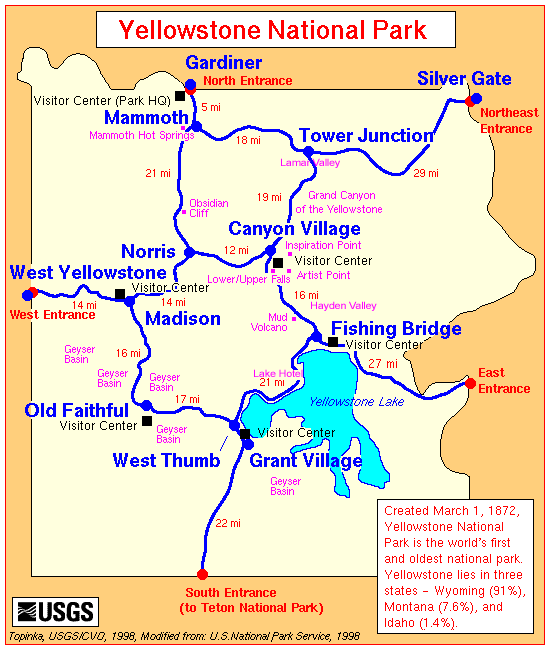

| This travelogue is one family's experience in Yellowstone. To see a photo in a 1024 x 681 size, just click on it. We hope you enjoy the record of our journey, and that you get to experience your own. Note: Stock photos of these and many other images with reproduction rights are available in their original 3008 x 2000 size. We also have a screen saver. Click here for more information. | |
| The Lamar and Hayden Valleys are separated by about 27 miles. They're the main wildlife areas in the park, especially during the winters when they're the park's warmest areas other than the geothermal areas, which can be dangerous for the animals. This is a shot of a lone buffalo near the road in the Hayden Valley. |

|
| Here is another shot of the Hayden Valley. The dots in the distance are a herd of buffalo. |

|
| The Lamar Valley, which is often called America's Serenghetti, has the largest concentration of both wolves and grizzly bears in Yellowstone. At the crack of dawn, we ventured into the Lamar Valley on a half-day Bear & Wolf wildlife safari with Carl Swoboda, the owner of Safari Yellowstone. We were only on our wildlife safari about 10 minutes when we stopped in the Blacktail Plateau area just adjacent to the Lamar Valley. I'm not sure how much Carl paid him, but within a minute, a grizzly bear magically appeared. I think the bear's agent asked for more, however, because the bear didn't come any closer to us. |

|
| After spotting the grizzly bear, we left the Blacktail Plateau area and toured the Lamar Valley and surrounding area in search of bears, wolves, and other wildlife. While we spotted some mountain goats and big horn sheep high on hillsides using Carl's high-powered spotting scopes (sorry, we have no pictures), we didn't spot any bears or wolves. However, Carl networks with several wolf researchers by cellphone and walkie talkies, and they converge together when a pack is spotted, which happened back in the Blacktail Plateau area about 8:30 am, so we returned there and hiked about a mile inland to a high nearby hill. Here's a panoramic view from the hill. |

|
| As we were hiking up the hill, we accidentally startled a cinammon-colored black bear sleeping near a tree. The bear jumped up the tree, and we made a detour to another route up the hill to avoid disturbing the bear, who then climbed down the tree and ended up sleeping for the rest of the morning as we observed the wolves from the nearby hilltop. In this shot with my 200mm telephoto lens, you can see the bear nestled at the base of the tree. He reminded me of my couch-potato golden retriever, who also likes to spend most of the day dozing off. |

|
| Here's a shot (from left to right) of park ranger, Rick McIntyre, Carl Swoboda, Kathie Lynch, and my wife Teresa, who are all observing the wolves through spotting scopes at a distance of about two miles. Rick and Kathie network with Carl, and joined us for the morning. We learned from them that the wolves -- seven adults and six pups -- were called the Blacktail pack and were led by a well-known tagged wolf named 302M. Ranger Rick has been following the wolves since they were reintroduced to the park in 1995, while Kathie Lynch, a high school biology teacher, observes the wolves every summer and writes a well-known blog on wolves. For more info on the wolf reintroduction program, Click here. |

|
| The circled area is where we observed the wolves for about 2-1/2 hours through our spotting scopes. We watched them play, hunt for food, and even chase a coyote unsuccessfully for about 30 seconds. Here's more info on the pack's alpha male, 302M, from Kathie Lynch's blog, "The star of the show has to be the illustrious 302M. Now nine-years-old and a character through and through, 302M is undoubtedly the most well-known wolf in the Park and perhaps the world. It is incredible that he finally became an alpha at the ripe old age of eight ... Veteran wolf watchers and visitors alike count it as a very lucky day when they get to see 302M!" Obviously, we were lucky! |

|
| While my colleagues were almost exclusively focused on the wolves, my wandering photographer's eye captured this little gem on the ground nearby -- a beautiful monarch butterfly (at least I think it's a Monarch, but I'm not sure). |

|
| As we left an absolutely amazing experience observing the wolves, we left one character behind -- our couch-potato bear, who still lay there as a lump of fur at the bottom of the tree. As you can see from our adventure, it's fairly obvious why I recommend going on a wildlife safari. |

|
| Click here to tour the Grand Tetons National Park.> |